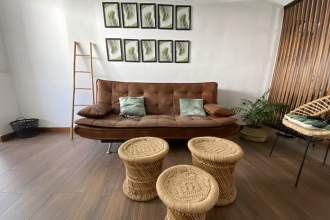Creating a bright and well-ventilated living space is crucial for maintaining a healthy and uplifting environment. Poor lighting and ventilation can lead to a range of issues, from feeling cramped and lethargic to more serious health concerns like mold growth and poor air quality. Fortunately, there are several simple yet effective strategies you can implement to enhance the brightness and ventilation of your rooms, ultimately promoting a healthier and more inviting living space.
Optimize Natural Light
Start by removing any obstructions blocking windows or doors, such as heavy curtains or furniture. Replace them with sheer curtains or blinds that allow sunlight to filter through while still providing privacy. Adding a VELUX window balcony can transform a room by providing an innovative solution that combines the benefits of natural light, ventilation, and outdoor access. Additionally, consider using light-colored or reflective surfaces for walls, ceilings, and floors to bounce natural light around the room.
Strategic Artificial Lighting
Supplementing natural light with artificial sources is essential, especially during darker hours or in rooms with limited access to sunlight. Choose LED bulbs with a color temperature of around 5000 Kelvin, which closely resembles natural daylight. Position light fixtures strategically to evenly illuminate the space, avoiding harsh shadows and glare. Installing dimmer switches allows you to adjust the lighting according to your needs, creating a cozy ambiance in the evenings.
Ensure Proper Ventilation
Adequate ventilation is crucial for maintaining indoor air quality and preventing the buildup of pollutants, moisture, and odors. Ensure that windows can be opened easily to allow fresh air to circulate throughout the room. Consider installing exhaust fans in areas prone to high humidity, such as bathrooms and kitchens, to remove excess moisture and prevent mold growth. Air purifiers with HEPA filters can also help remove airborne contaminants, allergens, and odors, improving overall indoor air quality.
Incorporate Indoor Plants
Indoor plants not only add a touch of greenery to your living space but also contribute to better air quality and overall well-being. Certain plants, such as spider plants, peace lilies, and snake plants, are known for their air-purifying properties, absorbing toxins and releasing oxygen into the air. Place these plants strategically near windows or in well-lit areas to thrive and effectively filter indoor air pollutants.
- Choose low-maintenance plants: Opt for indoor plants that are easy to care for and thrive in indoor environments with minimal sunlight and watering requirements, such as pothos, philodendrons, or succulents.
- Group plants together: Create mini indoor gardens by grouping plants, which not only enhances the visual appeal of your space but also increases humidity levels and promotes better air circulation around the plants.
- Rotate and repot regularly: Rotate your indoor plants periodically to ensure even growth and exposure to light. Repot them when necessary to provide adequate space for root growth and replenish soil nutrients, promoting healthier and more vibrant plants.
Utilize Mirrors and Reflective Surfaces
Mirrors are excellent tools for enhancing room brightness by reflecting natural and artificial light sources. Place mirrors strategically opposite windows or light fixtures to amplify the brightness in the room.
Additionally, incorporating reflective surfaces such as glass tabletops, metallic accents, or glossy finishes on furniture and decor can further bounce light around the space, creating a more open and airy feel. Be mindful of clutter and ensure that surfaces are kept clean to maximize their reflective properties.
Implement Space-Saving Furniture and Storage Solutions
Clutter can contribute to a feeling of darkness and stuffiness in a room, hindering both brightness and ventilation. To optimize space and airflow, invest in space-saving furniture and storage solutions.
Choose multi-functional pieces like ottomans with built-in storage or wall-mounted shelves to maximize floor space and minimize visual clutter. Keep furniture arrangement open and airy to allow for better air circulation and light distribution throughout the room.
Regular Maintenance and Cleaning Routine
Maintaining a bright and well-ventilated living space requires consistent upkeep and cleaning. Regularly dusting surfaces, vacuuming floors, and washing windows not only keep your home looking tidy but also remove dust and dirt that can obstruct natural light and impede airflow.
Pay special attention to areas prone to moisture buildup, such as bathrooms and kitchens, by regularly cleaning ventilation fans, air ducts, and drains to prevent mold and mildew growth. Additionally, replace air filters in heating and cooling systems as recommended to ensure optimal indoor air quality and ventilation.
Enhancing room brightness and ventilation is essential for creating a healthier and more inviting living space. By incorporating strategies such as maximizing natural light, utilizing artificial lighting effectively, ensuring proper ventilation, incorporating indoor plants, utilizing mirrors and reflective surfaces, implementing space-saving furniture, and maintaining a regular cleaning routine, you can transform your home into a bright, airy, and comfortable sanctuary. Prioritizing these aspects not only improves the aesthetics of your living space but also promotes better air quality, mood, and overall well-being for you and your loved ones.












